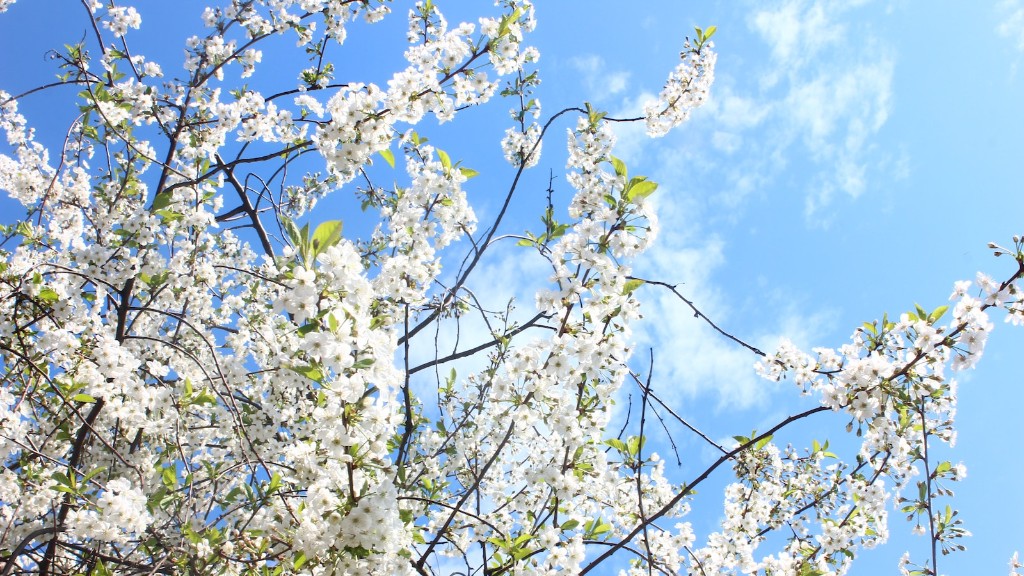Background Information
Cherry trees are fruit-bearing trees that are members of the Prunus genus, alongside other fruit tree varieties such as apricots, peaches, and plums. They are a popular choice for orchards, and have been cultivated since ancient times, with some even finding mention in the Bible.
Due to their popularity in orchards, many people are keen to learn more about the process of harvesting and caring for cherry trees, including when they can expect the harvesting of fruit. In this article we will explore the life cycle and timeline of a cherry tree before it bears fruit.
Planting and Growth Process
Before a cherry tree begins to bear fruit, it must first undergo the planting process. The trees are typically grown either from seeds planted directly into the soil, or from cuttings of existing trees. The best soil for cherry trees is typically well-draining and spongy, such as loam. It is important to ensure the soil has the correct pH balance and is free from disease. The tree should then be planted at the same depth as it was growing in the nursery.
Once planted, the tree begins the growth process, which typically takes two to four years. This process includes the tree becoming well-established in the new soil, forming roots and increasing in size. During this growth period, a cherry tree requires careful pruning and fertilizing. The tree will also produce foliage that then becomes flowers in late spring, typically followed by the growth of fruits.
Harvesting Timeframe
Once the tree has gone through the growth period and has produced flowers, it is typically three to five years until it begins to produce a large enough quantity of fruit that harvesting is recommended.
During this time, the tree should be well cared for and monitored, taking into consideration the recommended gardening practices for cherry trees, such as the amount and type of fertilizers, water and sunlight the tree needs. It is also recommended to use pest control methods to protect the tree from pests and disease.
Fruit Quality and Ripening
Once harvesting is recommended, the tree can typically be harvested for approximately two months, depending on the variety and the ripeness of the fruit. The window for harvesting also depends on the size of the tree, with trees over six feet in height typically producing a larger quantity and quality of fruit.
The key for successful harvesting is to pick the fruit when fully ripe. This means paying attention to the colour of the skin of the fruit; ripe fruit should have a deep red and slightly translucent colour. Once picked, the fruit can then be put in storage and will keep for several weeks.
Yield
The yield of a cherry tree depends largely on the size of the tree, with smaller trees of 12-15 feet in height typically yielding between 10 and 15 pounds of fruit per season. Larger trees of 6-10 feet in height can typically produce up to 60 pounds of fruit. Of course, the yield varies between varieties, with some producing more than others.
Nutrition and Health Benefits
Cherries are packed with various vitamins and minerals, and are a great source of antioxidants, which can help protect against illnesses and improve overall health. They also contain fibre, which can help to aid digestion, as well as iron, zinc, calcium, vitamin C and Vitamin A.
Environmental Factors
It is essential to consider the environment that a cherry tree is being grown in. The soil should have the correct balance of nutrients, moisture and sunlight, and the tree should be given the correct levels of care in order to thrive. Trees grown in ideal conditions will typically produce a larger yield and can produce fruit more quickly compared to those grown in less than ideal conditions.
Pests and Diseases
Pests and diseases can also be a factor when it comes to the lifespan and harvesting of a cherry tree. If left unchecked, pests and disease can cause the tree to produce a smaller yield or even die, making it important to check for them regularly and apply the necessary solutions.
Interesting Facts
Cherry trees are known for their longevity, with some trees producing fruit for up to 150 years. The trees can also be a great attraction for wildlife, including squirrels and birds, making them great to have in gardens.
Economic Impact
Cherries are a popular crop in many countries, with some varieties having a significant impact on the local economy. They can be found in supermarkets, farmers’ markets and other establishments, making them a valuable crop that can provide a good income for farmers.
Conclusion
In conclusion, it typically takes a cherry tree two to four years to go through the growth period before it begins to bear fruit. During this time, it needs to be well cared for using the recommended gardening practices. Once ripe, the tree can produce a large quantity of fruit for approximately two months, with larger trees typically producing the largest yield. As well as being a great source of nutrition, cherries can also have a positive impact on the local economy.

